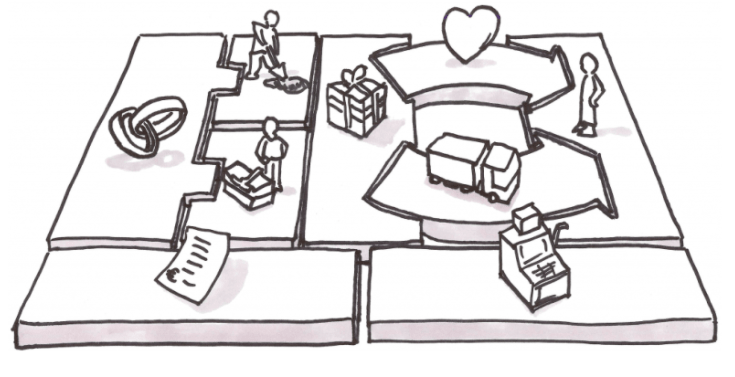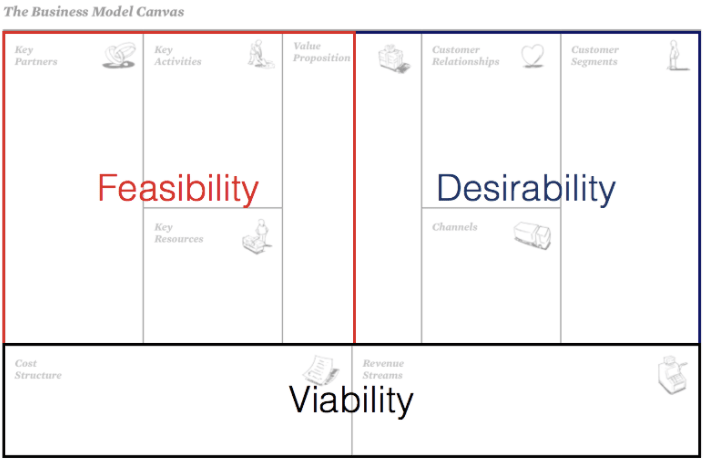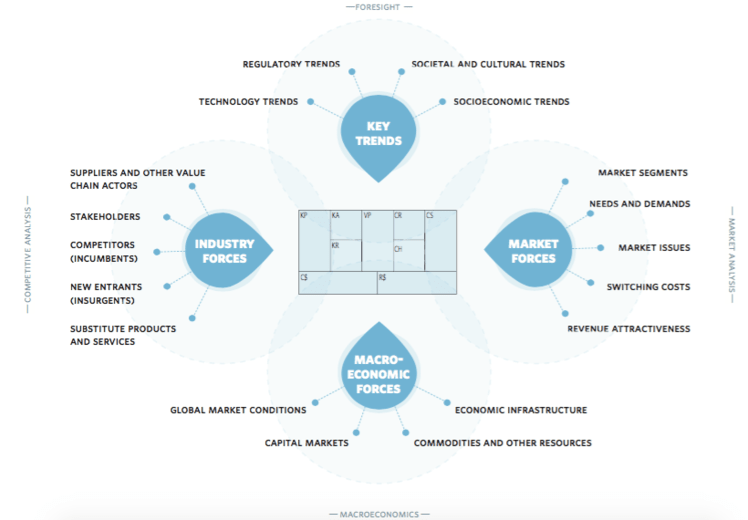BMC Part One: How To Use The Business Model Canvas
Image Credit: Strategyzer
If you’re using the Canvas, you’ll love my free Business Modelling eBook, full of tips for inventing and testing ideas that will change the world.
The Business Model Canvas, created by Strategyzer, is a tool that helps create and assess business ideas.
It’s free to use – all you need to do is print one out, or grab a whiteboard or sketch one out on a sheet of paper.
A canvas is a visual description of your idea, creating clarity for your team, your investors and yourself.
It won’t magically make your idea profitable, and it won’t do the work for you.
Instead, it makes you ask good questions, and good questions enable great ideas.
There are nine boxes, and this series will cover how they're each used and how to fill them in for your business.
You can jump straight in to each of them here:
Desirability: Customer Segments, Value Proposition, Customer Relationships, Channels
Feasibility: Key Resources, Key Activities, Key Partners
Viability: Cost Structure, Revenue Streams
The canvas is not simply a set of checklists, it's a way of finding the strengths, vulnerabilities and possibilities that lie beneath the surface of your idea.
For example, it will ask you why you hold your current assumptions.
· It will ask you if there are other people who could be your customers.
· It will ask if there are other reasons behind why people buy from you.
· It will ask if there are other ways of structuring your team.
· It will ask if you’re charging the right amount.
Most importantly, it will keep you accountable: all the little comforting lies we tell ourselves are hard to ignore when they’re out on a single page.
However, there’s one question that’s missing, so it’s important that we think about it now:
Why do you want to start this business?
Or if you’re already up and running
Why does your business exist?
J.P. Morgan said that behind every decision are two reasons – the good one and the real one.
Let’s be frank about the real reasons. What factors are driving your decisions?
Image Credit: IDEO
A helpful way of thinking about it is with IDEO’s Three Lenses of Innovation.
We call them Lenses, because they’re a way of examining one aspect of your business.
Each lens will highlight different strengths and weaknesses, and by looking at all three, we can create strong ideas that make money.
They are: Desirability, Feasibility and Viability.
Desirability is about understanding your customer, what motivates them, how they engage with you and what makes/breaks a purchase decision.
We need to be desirable to our customer, or else we’ll have no sales.
Feasibility is about how you make everything happen behind the scenes.
This includes hiring the right people, using the right tools, working with the right partners, and focusing on the right set of activities.
We need to run in a way that’s constantly feasible, or else we’ll implode.
Viability is about the dollars, how many we earn and how many we spend.
No matter your legal structure, you need a surplus to survive – meaning there’s money left over at the end of the day.
We need to be viable, or else we’ll go bankrupt.
You’ll probably find it easy to tick off two of the three.
That third one is the killer, and it can’t be ignored.
Our idea needs to sit at the heart of these three lenses.
Designing a business like this is tough, and it will take a fair few goes to get it right.
That’s what is so good about a canvas – it’s disposable, it’s free and it’s quick.
We can create an idea, test it, and fix any weaknesses.
Nine boxes sound like a lot, however they are simply better ways of describing our three lenses.
Image based on Strategyzer's Canvas
Desirability is explored through Customer Segments, Customer Relationships, Channels and Value Proposition.
Feasibility is explored through Key Resources, Key Activities and Key Partners.
Viability is explored through Cost Structure and Revenue Streams.
Grab your canvas, and let’s get started on the first box: Customer Segments…
This is a multi-part series on the Business Model Canvas.
If you’d like to jump straight to a particular section, go to:
Overview: How To Use The Business Model Canvas
Desirability: Customer Segments, Value Proposition, Customer Relationships, Channels
Feasibility: Key Resources, Key Activities, Key Partners
Viability: Cost Structure, Revenue Streams
Then once you've made your first canvas:
Reviewing: After Your First Model, Alarm Bells
Reinventing: Testing, What If?
Improving: Metrics, The Business Model Environment
Extensions: Pitching, Social Impact, Making It Great, What Next?











